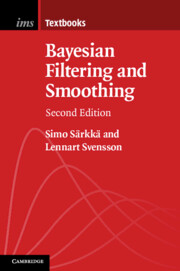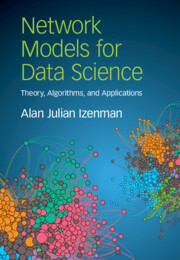Refine search
Actions for selected content:
980 results in Applied probability and stochastic networks
16 - Parameter Estimation
-
- Book:
- Bayesian Filtering and Smoothing
- Published online:
- 01 June 2023
- Print publication:
- 15 June 2023, pp 319-348
-
- Chapter
- Export citation
8 - General Gaussian Filtering
-
- Book:
- Bayesian Filtering and Smoothing
- Published online:
- 01 June 2023
- Print publication:
- 15 June 2023, pp 131-167
-
- Chapter
- Export citation
5 - Modeling with State Space Models
-
- Book:
- Bayesian Filtering and Smoothing
- Published online:
- 01 June 2023
- Print publication:
- 15 June 2023, pp 73-90
-
- Chapter
- Export citation
4 - Discretization of Continuous-Time Dynamic Models
-
- Book:
- Bayesian Filtering and Smoothing
- Published online:
- 01 June 2023
- Print publication:
- 15 June 2023, pp 44-72
-
- Chapter
- Export citation
15 - Particle Smoothing
-
- Book:
- Bayesian Filtering and Smoothing
- Published online:
- 01 June 2023
- Print publication:
- 15 June 2023, pp 308-318
-
- Chapter
- Export citation
9 - Gaussian Filtering by Enabling Approximations
-
- Book:
- Bayesian Filtering and Smoothing
- Published online:
- 01 June 2023
- Print publication:
- 15 June 2023, pp 168-203
-
- Chapter
- Export citation
Preface
-
- Book:
- Bayesian Filtering and Smoothing
- Published online:
- 01 June 2023
- Print publication:
- 15 June 2023, pp xi-xiv
-
- Chapter
- Export citation
11 - Particle Filtering
-
- Book:
- Bayesian Filtering and Smoothing
- Published online:
- 01 June 2023
- Print publication:
- 15 June 2023, pp 229-252
-
- Chapter
- Export citation

Bayesian Filtering and Smoothing
-
- Published online:
- 01 June 2023
- Print publication:
- 15 June 2023

Network Models for Data Science
- Theory, Algorithms, and Applications
-
- Published online:
- 22 March 2023
- Print publication:
- 05 January 2023
-
- Textbook
- Export citation
Chapter Five - Percolation on ℤ𝑑
-
- Book:
- Network Models for Data Science
- Published online:
- 22 March 2023
- Print publication:
- 05 January 2023, pp 105-135
-
- Chapter
- Export citation
Subject Index
-
- Book:
- Network Models for Data Science
- Published online:
- 22 March 2023
- Print publication:
- 05 January 2023, pp 477-484
-
- Chapter
- Export citation
Chapter Six - Percolation Beyond ℤ𝑑
-
- Book:
- Network Models for Data Science
- Published online:
- 22 March 2023
- Print publication:
- 05 January 2023, pp 136-160
-
- Chapter
- Export citation
Chapter Sixteen - Graphons as Limits of Networks
-
- Book:
- Network Models for Data Science
- Published online:
- 22 March 2023
- Print publication:
- 05 January 2023, pp 393-410
-
- Chapter
- Export citation
Chapter Fifteen - Examining Network Properties
-
- Book:
- Network Models for Data Science
- Published online:
- 22 March 2023
- Print publication:
- 05 January 2023, pp 374-392
-
- Chapter
- Export citation
Index of Examples
-
- Book:
- Network Models for Data Science
- Published online:
- 22 March 2023
- Print publication:
- 05 January 2023, pp 475-476
-
- Chapter
- Export citation
Chapter Ten - Parametric Network Models
-
- Book:
- Network Models for Data Science
- Published online:
- 22 March 2023
- Print publication:
- 05 January 2023, pp 239-271
-
- Chapter
- Export citation
Dedication
-
- Book:
- Network Models for Data Science
- Published online:
- 22 March 2023
- Print publication:
- 05 January 2023, pp v-vi
-
- Chapter
- Export citation
Chapter Nine - Network Sampling
-
- Book:
- Network Models for Data Science
- Published online:
- 22 March 2023
- Print publication:
- 05 January 2023, pp 218-238
-
- Chapter
- Export citation
Chapter Four - Random Graph Models
-
- Book:
- Network Models for Data Science
- Published online:
- 22 March 2023
- Print publication:
- 05 January 2023, pp 76-104
-
- Chapter
- Export citation
